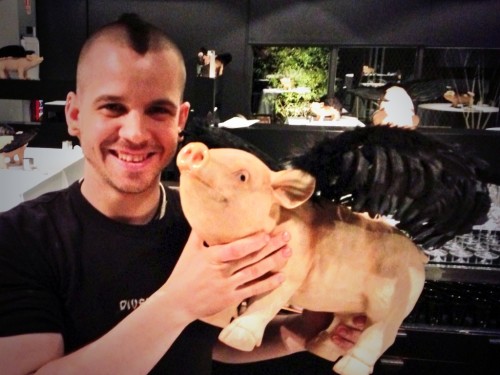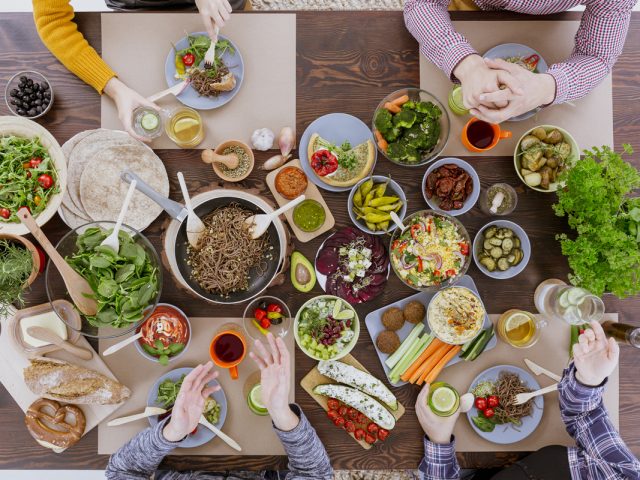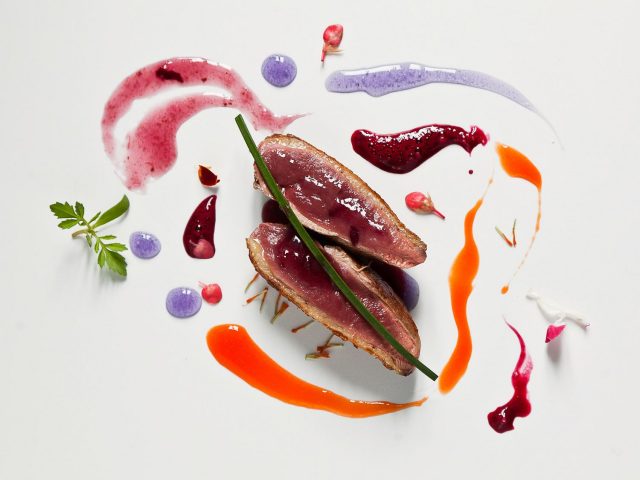- Have any questions?
- +34 951 273 575
- info@diningsecretsofandalucia.com
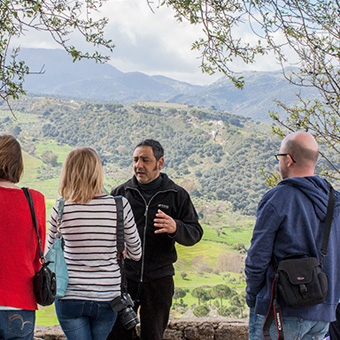
Heard it on the grape vine
31 December, 2013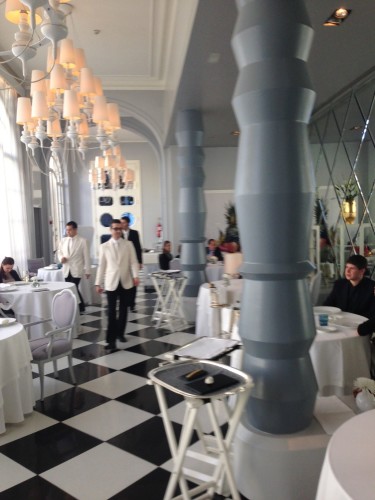
La Terraza del Casino, Madrid
21 January, 2014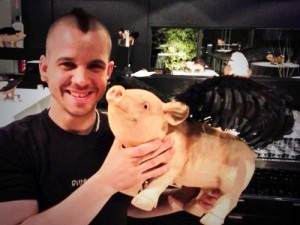
WITHIN 24 hours of being awarded the most coveted third Michelin star, David Munoz’s ground-breaking restaurant Diverxo received no less than 2,000 table requests, one of those from me.
Indeed, since hearing the news of his promotion to the rank of superchef (eight Spanish chefs currently hold the honour), the phone at his eccentric Madrid eaterie has literally not stopped ringing with Munoz using half a dozen employees to handle the enquiries.
“We are now totally full for lunch until April, dinner until June and a weekend dinner until the end of July,” beams Munoz, who at 33 is one of the world’s youngest chefs to win the highest accolade in cooking.
Moreover he is absolutely adamant that whoever is ringing – ‘celebrity, politician or king’ – they are not getting a table unless they do it the hard way.
“I don’t care if they are famous or not I want people to make their own reservation and get in line,” he tells the Olive Press, an hour before evening service at the joint that sits in an obscure location in north-west Madrid, next to a gym and entirely black and unmarked from the outside.
Does this even mean Spain’s most famous chef Ferran Adria, one of his mentors, where he has eaten no less than five times, each time personally calling the Catalan wizard to secure a table?
“It’s tough as he has always got me a table at El Bulli, but I would have to say ‘no’ as I do to everyone else as there is literally no space,” he explains in a mixture of Spanish and perfectly good English, a legacy of his six years spent living in London, the ‘best city in the world’, where he is set to open a restaurant in May.
Ultimately, it means I am not in luck. Despite making numerous attempted bookings through the restaurant’s automated online booking system for three different dates last weekend on a planned trip to Madrid, I failed on each attempt. Constant attempts to woo his PR and assistant also come to nothing and I am told the best I can hope for is ‘a cancellation’, but not to get my hopes up as I am not even top of the waiting list.
But, after much tooing and fro’ing I am promised at least 30 minutes of David’s time. He is a big fan of England, it transpires, and he has even ‘heard’ of the Olive Press!
So here I am sitting at a table at Spain’s restaurant of the moment, his trademark pigs lining the walls and a cloud of butterflies leading to the kitchen. But sadly, nothing is coming the other way. Not even a drink. “No tasting of product,” said the curt email as we arrived in Madrid on Friday afternoon. And that is exactly what came to pass.
The rise of Diverxo has been nothing short of spectacular, garnering its three Michelin stars in just six years – almost a record – and making it the first with such an honour since Zalacain dropped to two nearly two decades ago.
“It is fantastic news for the capital,” explains fellow up-and-coming chef Rodrigo de la Calle, whose own Michelin-star restaurant has recently just opened in the prestigious Hotel Villa Magna. “It really helps to put the city on the food map.”
Maitre Alfonso Vega of rival restaurant La Terraza del Casino, which has sat on two stars for a number of years, agrees. “It will really help to bring more tourists to the city and with 10% of Spanish tourism being gastro-led, there will be big repercussions.”
He adds: “Let’s face it Madrid is the perfect base as you can get to Valencia and Sevilla on the fast train in just over two hours and Barcelona in three-and-a-half. If Madrid starts to be seen as the new capital of food, it will bring in a lot more tourists.”
As a Madrileno himself, Munoz is extremely proud of his achievement. Sporting his trademark black Mohican and dressed top to toe in black, he boasts: “Until now, Madrid was the only capital city in Europe not to have a three-star restaurant. I am proud to have changed that.”
So why has it taken so long for Spain’s capital city to get such an honour?
Previously lovers of experimental, creative cuisine were far better served in the north of Spain, in the Basque region and Catalunya. While in Madrid, tourists concentrated more on tapas, heavy servings of roast suckling pig and the famously late boozy nights.
“Madrid has long been a conservative city when it comes to dining with the locals favouring asadors (carveries), tapas places and delis,” estimates Munoz. “But now with the recession people are taking more interest in what they are eating and demanding more.”
The vanguard had been led by Munoz’s first mentor Abraham Garcia from Viridiana, named after an arty Bunuel film from the 1960s.
He had first been taken to the eponymous Madrid eaterie by his parents who were both keen foodies. “My dad was an insurance agent and loved his food,” he explains. “He used to take us to different places at least once a month, which really gave me a taste for fine food.
“While my friends all wanted to be footballers or rock stars I grew up from the age of 10 or 12 wanting to be a chef.”
So, he started cooking at home and after landing a place at cookery school he managed to snare a job with his hero Garcia, before heading off for six years in London.
He opened his first restaurant in North Madrid after returning from his stint in London, where he worked at Hakkasan and Nobu.
It was a baptism of fire for both David and his now wife Angela Montero, a former ballerina, who both ended up sleeping at the restaurant for the first four months before it took off.
“We had a blow up bed we stuck in the corner. I was working 18 hours a day and it was simply not worth us heading home afterwards. We needed a solution and we were prepared to do it. If you really want something you have to fight for it.
“I knew it would be hard, but I wanted to be my own boss and wanted to do crazy things. I didn’t want to have to ask a boss every time I tried something. I almost did not leave the restaurant for weeks on end. We had one good supplier who came to us and we just cooked, cooked, cooked.”
Nowadays the pair can count on an incredible 45 different suppliers procuring the very best ingredients from all over Spain and abroad.
“I try to be as seasonal as possible and am as careful as possible about sustainability,” he continues. “We only serve fish when in season and if there is any question about a species being in danger we simply do not use it.”
But despite his success he is anything but happy with the price and general quality he finds in the capital, not to mention how hard it is to make a profit… even with three Michelin stars!
“People assume that a restaurant in Madrid would automatically have access to the best quality ingredients, but it is not true and they are expensive as well. Prices keep going up for fish, shellfish, oxtail, you name it. We end up spending around 20,000 euros a week alone on fish.
“We only have 28 covers and we try to keep the price down (his set menus are 95 and 140 euros, compared with 250 euros for example at Arzak in San Sebastian). Spain is a difficult place to run a restaurant business right now and I don’t know how we can keep the prices down.”
Ultimately though his cooking is shining through a competitive Madrid market that has improved many-fold over the last five years (there are five restaurants with two Michelin stars for example).
“My food is what I call total cooking. It is for people who like to eat and you have to come with an open mind. It is almost pornographic, completely natural and laid out bare. And I want the taste to be like a gunshot to the head.
“The philosophy for the restaurant is like my philosophy on life. I want it to blow your mind and be like a rollercoaster ride.”
Fortunately you can now get a taste of his philosophy at his latest project, a ‘pop up’, called StreetXo on the top floor of Madrid’s flagship Corte Ingles department store, in Callao.
So successful has been the opening this Autumn that he is now set to open one in London.
“It is going to be an ‘instense, crazy’ sort of place,” explains Munoz. “Like a cross between Cirque de Soleil and a Bangkok street restaurant, with a lot of emphasis on atmosphere.”
He has managed to find a total of 12 investors to stump up 1.5million euros for the restaurant in Burlington Street. And if it all goes well he plans to open in New York, Singapore, San Paolo and Dubai over the next couple of years. So why London first?
“I am mad about London and have a lot of friends there. I used to rent a flat, a tiny place, with some friends just behind Marble Arch. The concerts, the restaurants, the people who come from all over the world… and the food scene is so vibrant, way above Paris. There are so many influences, from Asia, the Americas. I know we will do well there.”
It is going to be an interesting year for Munoz, who will commute between London and Madrid weekly from May. He plans to work from Sunday to Tuesday in London and the rest of the week in Madrid. A day off? “Don’t be silly.”
So has anything changed since he opened six years ago? “Well I work less nowadays,” he says with his trademark grin. “Just 15 hours a day at the mo.”

